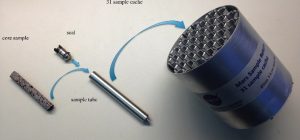With the successful launch of Mars2020 from Cape Canaveral today the first stage in a long and complex sample return plan is finally underway. Mars Sample Return has been envisaged for many decades but it is only since around 2008 that a feasible architecture has been developed.
Mars Sample Return has the ultimate aim of bringing back between twenty and thirty, 15 cm length, drill cores from in and around Jezero Crater. Mars2020 will cache the drilled samples, to be retrieved by a subsequent Fetch rover. This is turn will place the cached samples in a Mars Ascent Vehicle. That rocket will be intercepted in Mars orbit to be brought back to Earth, probably landing in the Utah desert some time around 2031. After all those new technical challenges the samples will have to be retrieved from the entry return capsule and housed in a Sample Return Facility. A big challenge there is analysing the samples whilst maintaining the strictest contamination and biological quarantine regulations. Over time the samples will be released to the wider scientific community and in that way the likely 500 g of drill cores will be analysed in greater detail and with a wider variety of instruments than is possible on a rover, to determine their mineralogy, chemistry and signs of ancient life.

Mars2020 Drill Cache
So, nothing like the 380 kg of rocks brought back by the Apollo missions, but with advances in analytical instrumentation since the 1970s, we can now determine isotopic abundances, organic compounds and mineralogy in minute samples. Apollo lunar analyses spurred on the development pf many instruments we today take for granted, such as mass spectrometers and radioisotope dating techniques. Similarly, we can expect Mars Sample Return to provide momentum in the search for ancient life beyond Earth, planetary science and a wide range of analytical techniques.

 Subscribe to jbridges's posts
Subscribe to jbridges's posts
Recent Comments